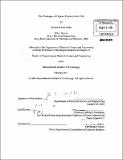The challenges of organic polymer solar cells
Author(s)
Saif Addin, Burhan K. (Burhan Khalid)
DownloadFull printable version (10.80Mb)
Other Contributors
Massachusetts Institute of Technology. Dept. of Materials Science and Engineering.
Advisor
Jeffrey C. Grossman.
Terms of use
Metadata
Show full item recordAbstract
The technical and commercial prospects of polymer solar cells were evaluated. Polymer solar cells are an attractive approach to fabricate and deploy roll-to-roll processed solar cells that are reasonably efficient (total PV system efficiency>10%), scalable and inexpensive to make and install (<100 $/m2). At a cost of less than 1$/Wp, PV systems will be able to generate electricity in most geographical locations at costs competitive to coal's electricity (at 5-6 cents/KWh) and will make electricity available to more people around the world (-20% of the world population is without electricity). In this chapter, we explore organic polymer solar cell technology. The first chapter discusses the potential impact of solar cells on electricity markets and the developing world and its promise as a sustainable scalable low carbon energy technology. The second chapter discusses some of the complexity in designing polymer solar cells from new materials and the physics involved in some detail. I also discuss the need to develop new solution processed transparent conductors, cost effective encapsulation and long life flexible substrates. The third chapter discusses polymer solar cells cost estimates and how innovative designs for new modules could reduce installation costs. In the final chapter I discussed the prospects for commercialization of polymer solar cells in several niche markets and in grid electricity markets; the commiseration prospects are dim especially with the uncertainty in the potential improvement in polymer solar cell stability.
Description
Thesis (M. Eng.)--Massachusetts Institute of Technology, Dept. of Materials Science and Engineering, 2011. Cataloged from PDF version of thesis. Includes bibliographical references (p. 108-110).
Date issued
2011Department
Massachusetts Institute of Technology. Department of Materials Science and EngineeringPublisher
Massachusetts Institute of Technology
Keywords
Materials Science and Engineering.